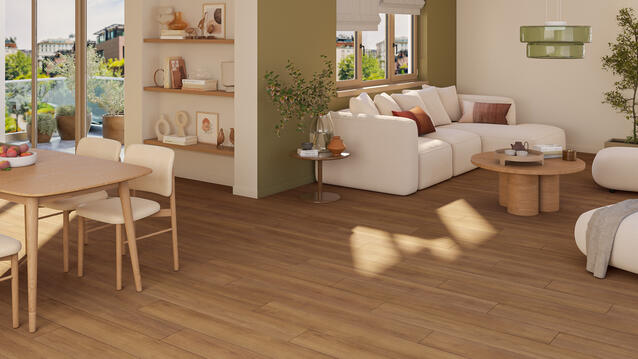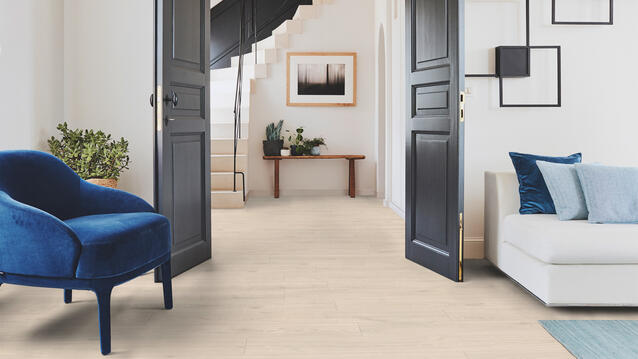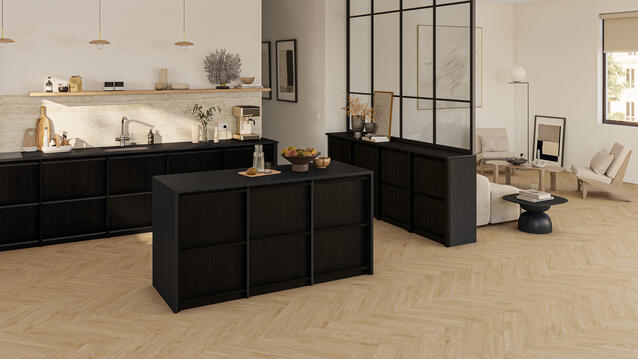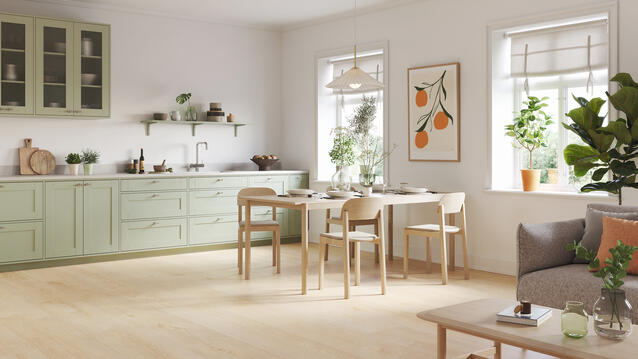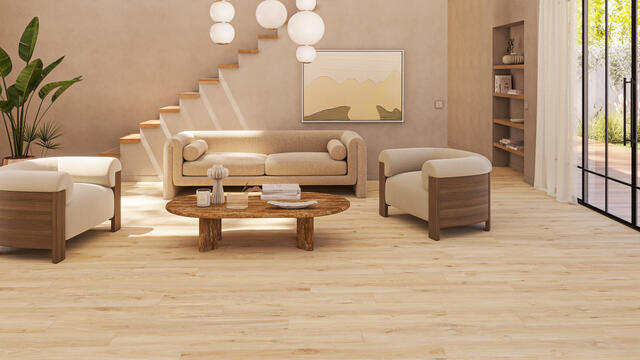
What is Laminate flooring and how is it made?
What is Laminate flooring and how is it made?
Laminate flooring is a multi-layer flooring material made from wood fiber that was designed to give the closest replication of natural wood material. It’s made from four main layers pressed in one single operation at a very high temperature and pressure.
- The bottom layer of our Laminate provides protection of the core board from moisure and guarantee dimensional stability.
- The core board is made of high-density fibreboard, from more than 80% wood, to provide exceptional structure strength and high resistance.
- On top is a premium decorative layer with a printed image to allow a wide variety of detailed design and beautiful colors and patterns.
- An innovative transparent surface protection, which sits on top to protect the surface from everyday wear and tear. It also helps maintenance thanks to its hard sealed surface which is stain-resistant, and ensures long lasting durability.
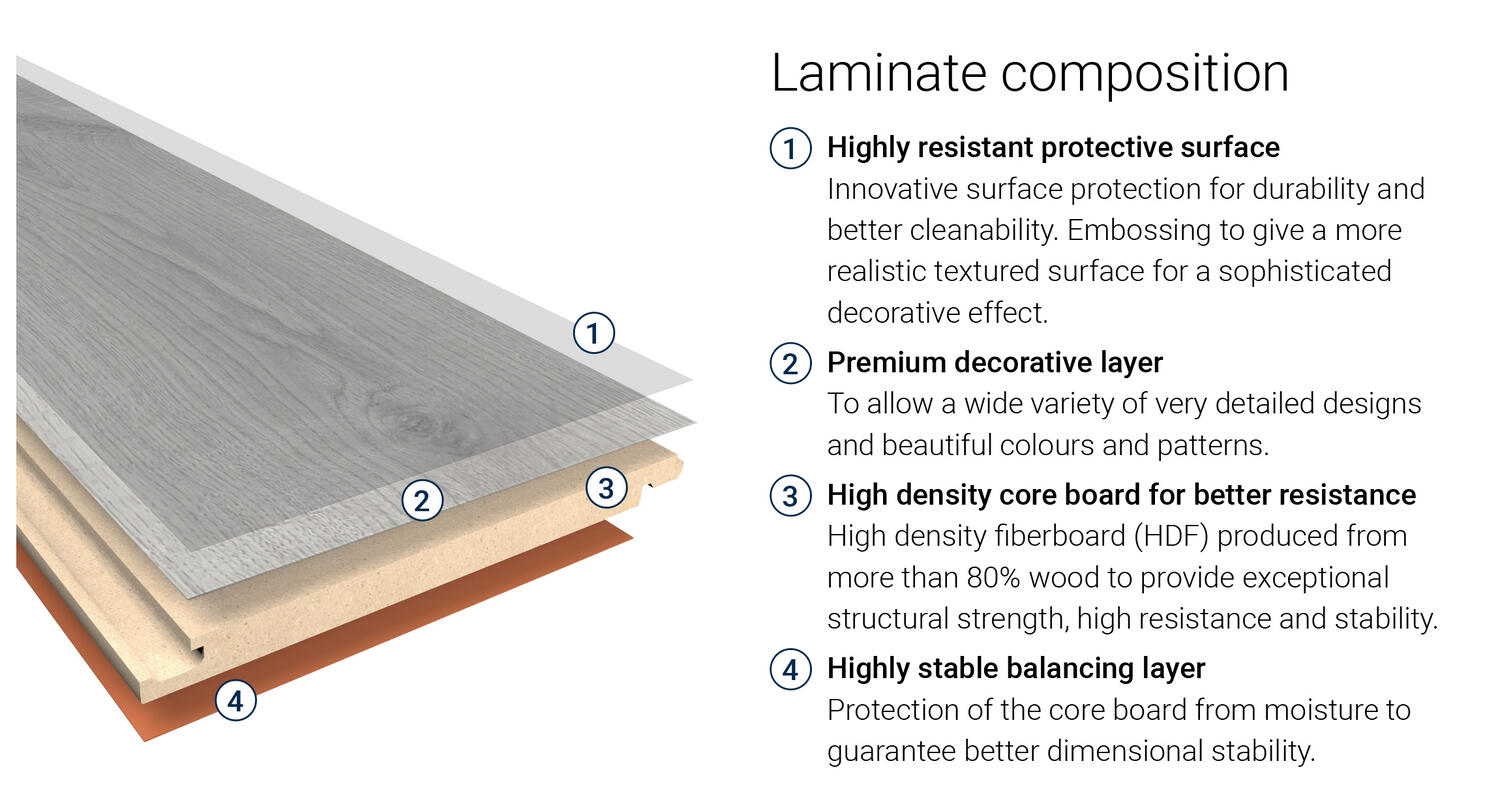
How durable is Laminate flooring?
Laminate flooring is highly durable. The high-density core board ensures excellent impact resistance and withstands heavy furniture without denting. The top layer protects the surface against scratching and fading, which makes Laminate the perfect choice for rooms where there are a lot of comings and goings such as in the living rooms or in individual homes or appartments with pets.
Laminate flooring solutions, suitable for residential spaces and light commercial traffic areas, offer water-resistant and water-repellent properties. These features are especially important in open kitchens, where the flooring needs to withstand day-to-day wear and tear. Available in the Easy Line and Woodstock AquaBlock collections only.
What are the advantages and disadvantages of Laminate flooring?
Advantages of laminate flooring
• Affordable : Laminate flooring is the ideal, affordable alternative to hardwood floors, offering a perfect wood material reproduction.
• Durable : the highly resistant protective surface makes Laminate resistant to protect the surface against scuffs, scratches, stains and fading.
• Easy to clean and maintain : the hard sealed surface with a stain-resistant overlay makes our Laminate floorings very easy to clean. A vacuum and a damp mop with mild detergent are all they need.The tight locking systems prevents dust and dirt from collecting between the boards. The dirt-repellent melamine resin surface is an excellent barrier against the growth or spread of germs, contributing to a healthier home environment in every living space.
• Easy to install : our Laminate flooring come with a new user-friendly locking system that makes easy and fast to install. Choose the installation method that suits you best : plank-by-plank, row-by-row, tapping.
• Save time : installing our Laminate floors does not require glue, several persons can work simultaneously, and floors can be used immediately after floating installation. This quick and easy installation makes it a time saving and economical solution.
• Excellent surface stability : as they withstand water, Laminate floors undergo minimal swelling. Hence, they work well in kitchens. Thanks to the closer-fitting joints, planks are very tightly jointed which ensure excellent surface stability. The height difference is reduced creating a beautiful, flat, surface.
Drawbacks of laminate flooring
• Even it’s made from wood, Laminate flooring is a replicative material – Depending on the quality of the photo used, Laminate can look not authentic when compared to the original material that it’s trying to mimic.
• Can’t be refinished – Laminate is a lot thinner than wood, and once the top layer of the laminate is damaged or worn, you can’t sand it down and refinish it like wood flooring.
• Susceptible to water damage – Under the resin-coated top layer, Laminate floors contain a layer of wood-chip composite. This means that you need to protect your Laminate floorings from potential water damage. You should clean up spills immediately. It's also essential to maintain the integrity of the top layer to prevent water from penetrating the surface. Standing water, improper cleaner with harsh scouring devices or cleaning products, and extreme impacts can prematurely wear down the floor’s top layer
• Difficult to repair – If one plank surface is damaged you have the option to restore it with a specific toolkit but if you need to change the plank because it’s highly damaged, the whole Laminate floor needs to be ripped out and replaced.
Find out more about Tarkett laminate collections.
How do you install Laminate flooring?
Our Laminate floors come with a new profile that makes them easy and fast to install. Choose the installation method that suits you best : plank-by-plank, row-by-row, tapping.
The installation of Laminate floors is a "floating" installation, which means that the planks connect to each other, but not to the sub-floor. A foam underlayment, which offers noise attenuating properties, has to be sitted between the Laminate and the subfloor. Floors can be used immediately after floating installation.
No special tool or skills is needed to install a Laminate floor. The Laminate planks can be cut with a hand saw or sometimes a jig saw. Installing our Laminate floors does not require glue. It means that even inexperienced homeowners can install a Laminate floor themselves. Several persons can install Laminate simultaneously. Depending on the size of your room, you can generally install Laminate flooring in a day. This quick and easy installation makes it a time saving and economical solution.
Find out more about laminate flooring installation.
How do you maintain Laminate flooring?
Laminate flooring is fairly low maintenance. When applied regularly, these tips will help keep your floor looking as good as the day you laid it:
• Daily: wipe or vacuum.
• Once a week or more: wipe the floor with a damp mop or a cloth moistened with warm water and a neutral detergent.
• Whenever necessary: remove dust with a broom or vacuum cleaner to avoid dust and dirt build-up.
• It is advisable not to let the water station on the floor for a long time.
• Avoid using harsh scouring devices or cleaning products as these can wear down the floor’s top layer.
• Place pads and soft castors under table legs and chairs to prevent scratches and dents.
• Lift furniture rather than drag or push it on your laminate flooring to avoid damage.
Find out more about laminate flooring maintenance.
Can you use Laminate flooring in any room in your home?
Laminate flooring can be installed in most rooms in your home. However, it’s not recommended in the bathroom or laundry room. Our Laminate floors are suitable for heavy domestic use, particularly in kitchen area, where flooring needs to withstand day-to-day home life. Thanks to its hard sealed surface, our Laminate floor is stain-resistant, meaning that spills and drips, food stains, heat and dropped ustensils, as well as the constant traffic, are not a problem.
What is the difference between Laminate and engineered wood flooring?
Laminate and engineered wood flooring share several similarities, but there are some key differences between them. Laminate flooring and engineered wood flooring are both made from several layers of compressed materials. The core of Laminate consists of compressed wood material strengthened with resin with a printed image (usually of wood but it can also be of stone) on top and covered by a resistant overlay to protect the floor surface. Engineered wood flooring, on the other hand, is made from layers of compressed materials with a layer of solid wood on top.
So what is the main difference between Laminate and engineered wood? Laminate is replicating wood, due to the photo that sits just under the top, transparent layer, whereas engineered wood floors are made with real wood and have a solid hardwood layer on top.
At Tarkett, we make our engineered wood flooring entirely from real wood. We then add a top layer of solid hardwood in a variety of species and designs and apply a stain and heat treatment. Our engineered wood floors also have a strong and supportive middle layer made of transverse wood with fibres that contributes to the stability of the boards, and a balancing layer that stabilises the board and guarantees dimensional stability.
Price will also be a major difference, engineered wood flooring is always more expensive than Laminate flooring.
